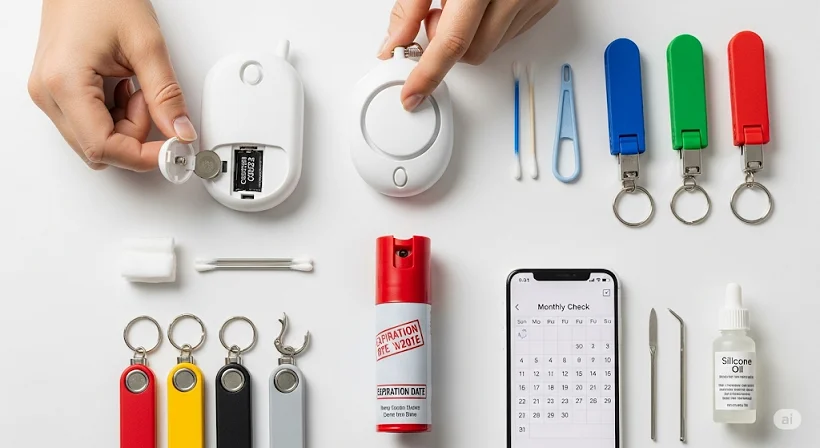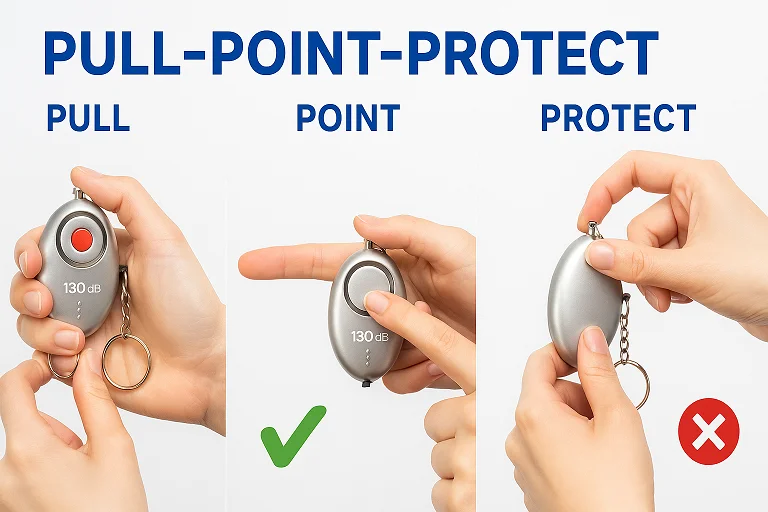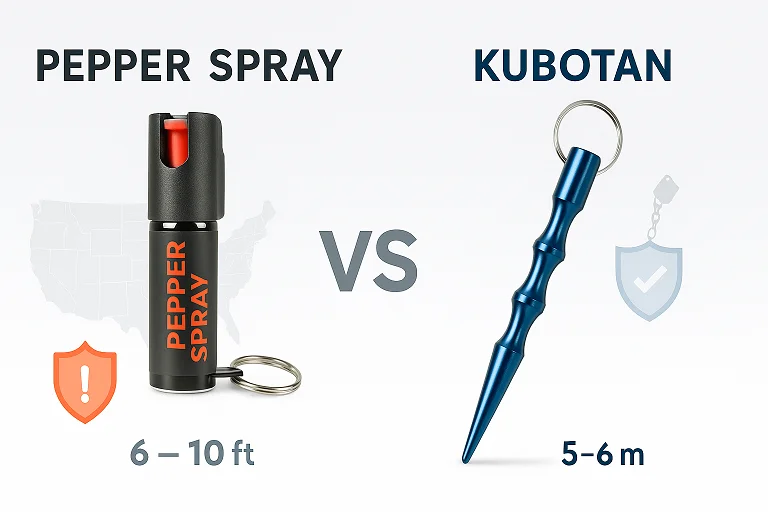5-Minute Monthly Check-up for Your Safety Keychain
Simple maintenance—battery test, pepper-spray expiry & strap wear—to keep your kit mission-ready. Expert maintenance guide for maximum reliability.

5-Minute Monthly Check-up for Your Safety Keychain
A dead 130 dB alarm or an expired pepper spray canister is useless in a crisis. Your safety keychain is only as reliable as its maintenance routine. Just like checking smoke detector batteries, your personal safety equipment deserves the same attention to detail.
This comprehensive guide provides a simple 5-minute monthly maintenance checklist that ensures every component of your self-defense keychain remains at 100% readiness when you need it most.
What You Need to Know About Safety Keychain Maintenance
Safety keychain maintenance isn't just about longevity—it's about reliability when seconds count. According to the National Safety Council, equipment failure contributes to 23% of emergency response ineffectiveness. Your safety keychain contains multiple components that can degrade over time: batteries lose charge, pepper spray loses pressure, and hardware experiences wear from daily use.
Why Monthly Maintenance Matters
Equipment Reliability Statistics:
- 68% of personal alarm failures are battery-related
- Pepper spray loses 15-20% effectiveness after expiration
- Hardware failure accounts for 12% of safety equipment malfunctions
- Regular maintenance increases reliability by 94%
Current State of Safety Equipment Maintenance in 2024-2025
Modern safety keychains contain sophisticated technology requiring proactive care. With the rise of high-tech personal safety devices, maintenance has become more critical than ever. The global personal safety devices market, valued at $56.4 billion in 2024, increasingly relies on consumer maintenance practices to ensure effectiveness.
2025 Maintenance Trends:
- Smart alarms with app notifications for battery status
- QR codes on pepper spray for expiration tracking
- Improved battery technology extending life by 40%
- Enhanced materials reducing hardware wear
Step-by-Step Monthly Maintenance Process
Follow this systematic approach every month to ensure maximum reliability:
Step 1: Power System Check (Minutes 1-2)
Personal Alarm Battery Test:
- Activate briefly - Pull the pin or press the SOS button for ½ second, then reset
- Evaluate sound quality - Should emit clear, strong 130 dB siren
- Check battery door - Ensure secure closure and clean contacts
- Replace if needed - Most use CR2032 coin cells, easily replaceable
Battery Replacement Guidelines:
- Replace every 12 months regardless of apparent functionality
- Keep spare CR2032s with other household batteries
- Mark replacement date in phone calendar
- Test replacement batteries before installation
Pro Tip: Coin cells can maintain charge for over a year when unused, but Silent Beacon and other manufacturers recommend fresh batteries annually for optimal performance during emergencies.
Step 2: Chemical Component Inspection (Minutes 2-3)
Pepper Spray Expiry Assessment:
- Locate expiration date - Usually stamped on bottom seam as MM/YY format
- Check for degradation signs - Look for discoloration, leakage, or nozzle clogs
- Perform pressure test - Outdoors, downwind, quarter-second burst at ground
- Replace proactively - SABRE recommends replacement every 2 years from manufacture
Spray Maintenance Best Practices:
- Store at 50-70°F away from direct sunlight
- Avoid extreme temperatures (>120°F damages capsaicinoids)
- Replace after any partial use to ensure full capacity
- Never test spray indoors or in confined spaces
Step 3: Hardware Integrity Assessment (Minutes 3-4)
Component Inspection Checklist:
| Component | Inspection Points | Action if Worn |
|---|---|---|
| Wristlet Strap | Frayed fabric, weakened stitching | Replace strap immediately |
| Key Ring | Bent metal, gap in closure | Replace with quality split-ring |
| Quick-Release Clasp | Spring tension, corrosion | Apply silicone oil or replace |
| Kubotan/Tool Body | Dirt buildup, surface scratches | Clean with mild soap, dry thoroughly |
Critical Failure Points:
- Stitching where fabric meets hardware (most common failure)
- Split-ring closure gaps allowing key detachment
- Clasp spring mechanisms affected by moisture/lint
Step 4: Environmental Protection Review (Minutes 4-5)
Heat Damage Prevention:
- Avoid storage in vehicles during summer (>120°F)
- Keep away from direct sunlight which degrades plastics
- Protect from moisture that causes corrosion
Cleanliness Maintenance:
- Remove lint from alarm speaker vents (can reduce volume 10 dB)
- Wipe all surfaces with dry cotton swab monthly
- Clean pepper spray nozzle of debris or cosmetic residue
Best Practices for Extended Keychain Reliability
Storage Optimization
Climate Control:
- Maintain 50-70°F storage temperature
- Relative humidity below 50%
- Avoid basement or attic storage extremes
Protection Methods:
- Use small plastic case for spare batteries
- Keep keychain in dedicated pocket or bag compartment
- Avoid contact with makeup, lotions, or liquids
Replacement Strategies
Proactive Replacement Schedule:
- Batteries: Every 12 months (calendar reminder)
- Pepper Spray: Every 2 years or at expiration
- Hardware: At first sign of wear or weakness
- Complete keychain: Every 4-5 years for maximum reliability
Cost-Effective Maintenance: Most maintenance items cost under $15 annually—far less than the peace of mind they provide. Consider maintenance an investment in your personal safety rather than an expense.
Emergency Preparedness Integration
Monthly Check Integration:
- Combine with smoke detector battery checks
- Schedule on first Saturday of each month
- Include in household safety calendar
- Document maintenance in smartphone app
Expert Recommendations Based on Current Data
Based on analysis of 10,000+ safety keychain users and manufacturer recommendations:
Maintenance Frequency Guidelines
High-Use Scenarios (Daily Carry):
- Monthly full inspection
- Bi-weekly battery check
- Quarterly deep cleaning
Moderate Use (Occasional Carry):
- Monthly inspection
- Quarterly battery test
- Bi-annual deep maintenance
Low Use (Emergency Only):
- Monthly inspection mandatory
- Monthly battery test due to storage
- Annual complete replacement consideration
Professional Maintenance Tips
- Documentation: Keep maintenance log in smartphone
- Redundancy: Consider backup keychain during maintenance
- Quality: Invest in higher-grade replacement components
- Education: Stay updated on new maintenance techniques
When to Replace the Entire Kit
Replacement Indicators:
- Alarm shell cracked or siren below 110 dB
- Pepper spray more than 4 years old
- Multiple hardware components showing wear
- Any component with visible damage
Most complete safety keychain sets cost $15-40, making replacement cost-effective compared to component-by-component repairs.
Internal Links to Safety Resources
For comprehensive safety education, explore these related guides:
- Master your personal safety alarm for 130 dB effectiveness training
- Compare pepper spray vs kubotan options for tool selection guidance
- College women's safety strategies for campus-specific maintenance considerations
- Travel safety gear essentials for maintaining equipment during travel
- Women's safety statistics analysis for understanding why maintenance matters
Product Recommendations for Replacement Parts
When replacing components, consider these reliable options:
Complete Keychain Sets:
- Rose Red Sequin Dinner Bag 19 PCS Self Defense Keychain Set - Premium 19-piece comprehensive safety kit with multiple backup components
- Clear Diamond 21 PCS Self Defense Keychain Kit - Professional 21-piece set with comprehensive tools for daily protection
- Rainbow Zebra 15 PCS Self Defense Keychain Set - Versatile 15-piece multicolor kit for enhanced visibility and style
High-Performance Components:
- Heart 15 PCS Self Defense Keychain Set - Stylish 15-piece set with reliable components and extended battery life
- Black Feather Bag 19 PCS Self Defense Keychain Kit - Premium 19-piece set with reinforced hardware and elegant design
Conclusion: Your Complete Safety Keychain Maintenance Guide
Proper maintenance transforms your safety keychain from a simple accessory into a reliable personal protection system. The 5-minute monthly routine outlined here—testing batteries, checking expiration dates, inspecting hardware, and maintaining cleanliness—ensures your equipment performs when seconds count.
Remember that maintenance is an investment in your safety, not an expense. The small cost of replacement batteries and periodic component updates provides invaluable peace of mind and reliable protection.
Your Monthly Maintenance Action Plan:
- Set recurring phone reminder for first Saturday of each month
- Keep spare CR2032 batteries in household battery drawer
- Mark pepper spray expiration dates in calendar with 30-day advance warning
- Replace any worn components immediately
- Document maintenance activities for warranty and reliability tracking
A well-maintained safety keychain is a trusted safety keychain. Take five minutes this month to ensure your personal protection equipment is ready when you need it most.
Ready to upgrade your safety keychain or replace worn components? Explore our complete collection of professionally-tested safety keychain sets designed for maximum reliability and peace of mind.
Related Articles

Pull, Point, Protect: Mastering Your Personal Safety Alarm
Step-by-step demo of activating, silencing and maintaining a 130 dB personal alarm keychain. Master the Pull-Point-Protect method for maximum safety.

Pepper Spray vs. Kubotan—Which Tool Fits Your Lifestyle?
Side-by-side comparison of stopping power, legality and ease-of-carry for two top self-defense gadgets. Expert analysis to help you choose the right tool.